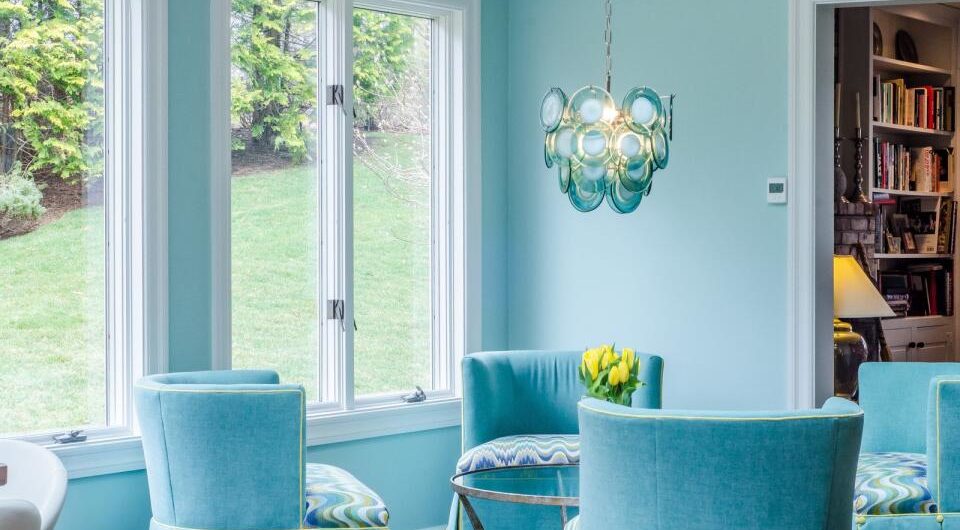It is important to understand how colour can affect your mood and thoughts if you’re going to create and maintain good vibes in your space.
The colours we select to decorate our home can have a subconscious effect on our productivity and state of mind.
Colour theory is the concept that the colours we surround ourselves with can have an effect on our health – whether physical or mental. Every colour- from black to white and everything in between – can affect how a person thinks, acts and responds to daily occurrences.
For example, when decorating a room in hues of white it can generate a feeling of purity and relaxation while red can create a feeling of increased energy.
The team of mental health specialists at Delamere have shared the influence of seven different decorating colours below.
Blue
Blue can generate a feeling of calmness and serenity. It is often associated with tranquillity, peace and security. Adding blue to your home can help to manage stress. It is considered a very soothing colour that helps calm the mind, reduce anxiety, slow down heart rate, and lower blood pressure.
This was confirmed in a study carried out by Siegfried E Katz of the New York Psychiatric Institute. The researchers discovered that hospitalised patients found blue to be the best colour to become exposed to. The research also implied that those suffering from mental health disorders are more likely to associate with the colour blue more than any other.
Blue, and in particular navy, conveys a sense of trust and authority which makes it the perfect colour for formal environments, such as home offices. When choosing the right shade of blue for your living, dining space or bedroom, it’s best advised to opt for a soft and neutral shade to reap the tranquil benefits.
Green
Green is often used throughout bedrooms and living areas due to its restful and quiet nature. The positive psychological properties green communicates are beauty and comfort as it symbolizes nature and feeling refreshed. Light hues of green and pale yellow-greens can diffuse anxiety, as they communicate a feeling of new life.
Green is a versatile colour that can be used to complement a variety of colour palettes as either a neutral addition or the main focal colour. Add life to any green room with outdoor plants, as they will bring in a feeling of calmness and relaxation.
Yellow
Yellow is the colour of optimism, brightness, enthusiasm and mental clarity. There is something very energetic about the colour that makes people feel lively and confident. A person surrounded by yellow generally feels more joyful and happy as the brain releases more serotonin.
If you want to start your day on a high, add yellow to your bedroom or living space, as it’s known to increase concentration and help with fast decision making during stressful situations. However, too much exposure to yellow, in particular, deep shares can cause irritability, and a short temper, especially around children and babies.
Orange
Orange is often used to grab attention within advertising and traffic signs, due to its bold and energetic qualities. Too much orange can be overwhelming, irritating and frustrating when used throughout the home.
But when used in moderation, it can invoke feelings of sociability, enjoyment and happiness, making it a perfect choice for gathering spaces. It’s great to use a pop of orange in your living or dining area!
Grey
Grey represents neutrality and balance. The colour has been a big interior trend in recent years, with many introducing the neutral shade into their homes. While grey might be considered a dull and boring colour by many interior experts, when the colour is paired with neutral tones, pastels and white it can create a relaxing and serene atmosphere.
However, grey should be avoided in rooms for infants and children, and any rooms that require creativity. This is because grey is widely considered to be an uninspiring colour, and one that evokes a lack of confidence.
Pink
Pink promotes tranquillity and peace, as is associated with love and kindness. It is a positive colour that inspires feelings of warmth and comfort. Pink can calm and reassure our emotional energies, reduce negative feelings of anger, aggression, abandonment and neglect.
Research has confirmed the mental health benefits of incorporating pink throughout your home. The study found that stress levels were significantly reduced amongst students when exposed to the colour pink.
Adding pink to your home doesn’t mean you suddenly need to paint the walls or change your carpet. It can be incorporated through accessories, such as vases, candles, rugs and towels.
Red
Red within a home environment can increase heart rate and stimulate chemicals associated with aggression and high energy, that’s why it’s recommended to avoid.
While red is often used to promote energy and social interaction, the intense colour endured for a long period of time can make us irritable, more aggressive and less relaxed.




